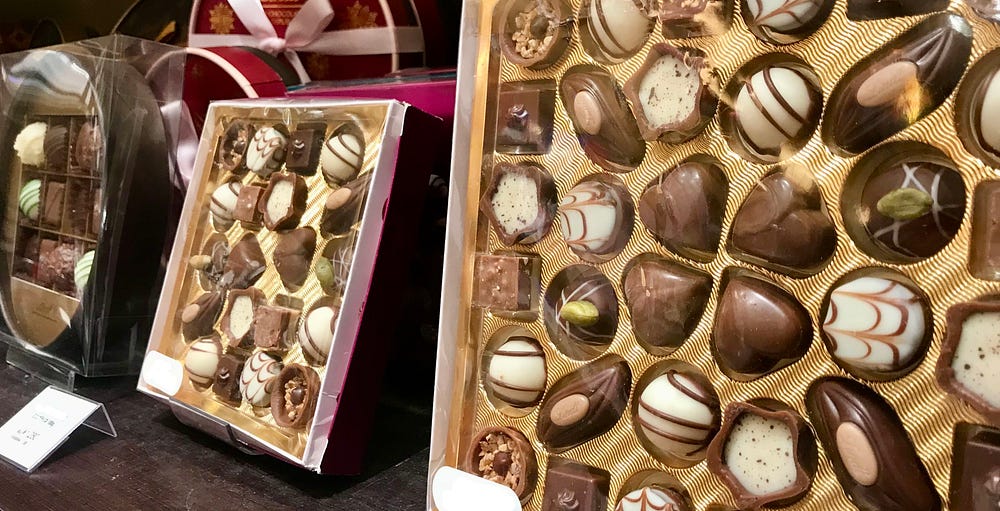Turnabout is fair play

Growing up in the US, I enjoyed Valentine’s Day parties in our classrooms at elementary school. Each child gave every other child a very inexpensive little card, and we all ate heart-shaped sweets.
Television showed images of men giving flowers and heart-shaped boxes of chocolates to their sweethearts.
Good ole Valentine’s Day.

Then I moved to Japan.
History of Valentine’s Day in Japan
In 1936, the founder of the Kobe-based Morozoff chocolate company heard about Valentine’s Day from an American friend. He took out an ad in the country’s English language newspaper, The Japan Advertiser — “Let’s give chocolate to our sweethearts for Valentine’s Day.” This caused a spark of interest but met with minimal success. The ad had only targeted English speakers, and the drums of war were already beating in Japan. People were not in the mood.
Fast forward 20 long and difficult years.
In 1958, another chocolate maker, Mary’s, held a Valentine’s Day sale at the Isetan Department Store in Shinjuku, Tokyo. In contrast to the Western tradition of men giving gifts to women, Japanese advertisements urged women to use this one day a year to confess their true feelings to the man they loved.
The economy was starting to boom. People were becoming interested in Western customs. The fire was lit.
In 1965, the first Valentine’s Day Fair was held at Isetan. From then on, Valentine’s Day sales spread to other department stores and shops. With women as the target buyers, the chocolates became increasingly fancier and cuter.

Obligatory vs True Love Chocolates
The first chocolates given came to be known as honmei-choko, “true love chocolates.” But by the 1980s, the popularity of Valentine’s Day had increased to include chocolate given to co-workers or even classmates — if the teachers didn’t catch the students, that is. Schools do not allow such frivolities as the exchanging of chocolates among friends on Valentine’s Day. But kids find a way.
Gifts of chocolate among co-workers are called giri-choko, “obligation chocolate,” and among friends is called tomo-choko, “friend chocolate.” It is understood that no romantic feelings are attached.
White Day
There is a deep-rooted custom in Japan that when one receives a gift, one must give something in return. This may partially explain why people play down the gifts they give, so as to negate feelings of obligation to reciprocate.
With this custom in mind, in the late 1970s, various members of the National Confectionery Industry Association came up with ideas to create an answer to Valentine’s Day — Marshmallow Day, Candy Day, Cookie Day — but none had quite the right ring to it.
It seems the real credit for White Day should go to an executive with the Fukuoka-based Ishimura Manseido company. After a few years of measured success with Marshmallow Day, he came up with the brilliant idea to name the day after the color of the marshmallows — white and pure like true love — and White Day was born on March 14, 1978.
On White Day, men who received gifts of chocolate on Valentine’s Day return gifts of cookies, cakes, or other sweets to those women who gave them chocolate.
Trends are Changing
According to a 2020 survey of 2,000 people by JR Tōkai Takashimaya, the popularity of giving giri-choko has waned, with only 6% of those surveyed responding that they bought “obligation chocolate.” 15% bought honmei-choco, “true love chocolate,” and 26% bought chocolate for family members.
The largest percentage, 46%, bought chocolate for themselves. Another survey found that 60% of women bought chocolate for themselves.
I can understand. Those department store displays of chocolate are pretty hard to resist. I might just pick up some Valentine’s Day chocolates myself, but I’ll wait until the evening of the 14th or the next day when prices are slashed.
Happy Valentine’s Day!

P.S. Why March 14th?
Different theories have been advanced as to why March 14th was chosen as White Day. One claims it was the day Christians who were married in secret by Saint Valentine pledged their undying love. Others say the date was taken from the ancient histories of Japan. It seems that knowledge is lost to time.
References:
https://www.candy.or.jp/whiteday/okuru.html, https://plustrivia.com/events/317/, https://bit.ly/3nLS8nl, http://iroha-japan.net/iroha/A01_event/06_wd.html, https://www.ishimura.co.jp/whiteday/birth.html, https://www.nippon.com/en/features/jg00025/valentine%E2%80%99s-day-and-white-day.html
If you have questions about Japan or suggestions for articles, please add them in the comments. For more photos and information on Japan, follow me on instagram at: https://www.instagram.com/more_than_tokyo/




